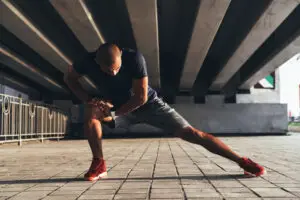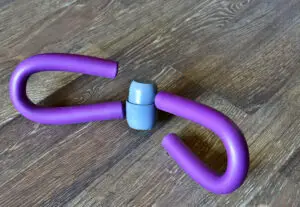Incorporating leg stretches into your workout routine is essential for maintaining lower body mobility and preventing injury. Ensuring flexibility in your lower body can greatly improve your performance during exercise and help reduce post-workout soreness.
A well-rounded stretching routine should target various muscle groups, such as hip flexors, hamstrings, quadriceps, and calves.
Before launching into an intense workout, it is crucial to select the right leg stretches that will prepare your muscles for the upcoming activity. A proper warm-up including leg stretches can enhance muscle elasticity, improve blood circulation, and lead to a more effective workout experience.
It is important to note, however, that dynamic stretches are recommended before a workout, while static stretches are better suited for post-workout cooldowns.
This article will discuss the best leg stretches to include in your pre-workout routine, ensuring your muscles are warmed up and ready for optimal performance.
Incorporating these targeted stretches can make a significant difference in preventing injuries and maximising the benefits of your workout.
Why Pre-Workout Stretches are Essential
Properly stretching before a workout is a crucial aspect of any exercise routine, as it significantly contributes to the efficacy and safety of an individual’s performance. Stretching provides several benefits to both recreational and professional athletes, helping to maintain and improve various aspects of physical fitness.
One of the primary advantages of pre-workout stretching is the increased range of motion in the joints. By gently stretching the muscles and connective tissues, individuals can enhance their flexibility, allowing for more fluid and comfortable movements throughout their workout. This improvement in the range of motion can also lead to better-stabilised joints during exercise, resulting in overall better form and technique.
Furthermore, the act of stretching can help prevent injury. When muscles are tight or inflexible, they are more susceptible to strains and tears. By warming up with stretches, individuals can effectively reduce the risk of muscle damage and injury. This is particularly important for those engaging in high-impact or strenuous activities, such as running or weightlifting.
Stretching also plays a vital role in preparing the body for exercise by slowly increasing the heart rate. As the heart rate rises, blood flow and oxygen supply to the muscles are gradually improved, helping the body to transition from a resting state to a more active, ready-to-work state. This gradual warm-up allows the body to better adjust to the demands of the exercise, reducing the likelihood of injury and improving overall performance.
In addition to injury prevention and improved performance, pre-workout stretching can also alleviate muscle soreness. Often, individuals experience delayed onset muscle soreness (DOMS) following a rigorous workout. Stretching before exercising can help to reduce this soreness by promoting better circulation and flexibility in the targeted muscles, thus mitigating the discomfort associated with DOMS.
In summary, incorporating pre-workout stretches into one’s exercise routine is essential for various reasons, including enhancing flexibility, decreasing the risk of injury, promoting adequate circulation, and reducing muscle soreness.
By dedicating time to stretching before engaging in a workout, individuals can experience a safer and more effective exercise experience.
Common Tips for Effective Stretching
When it comes to leg stretches before a workout, it is essential to follow a few guidelines to ensure effectiveness and safety. Whether you are preparing for a cardio session or a strength training exercise, these tips will help improve your flexibility, balance, mobility, and overall performance.
First and foremost, always warm up your body before diving into stretching exercises. A proper warm-up enhances blood circulation, loosens up muscles, and prepares the body for more extensive movement.
Simple exercises like jogging on the spot, some light cardio movements, or even marching can serve as excellent warm-up activities. Remember, stretching cold muscles can increase the risk of injury, such as muscle tears.
Pay special attention to the major muscle groups involved in your workout. For exercises focused on legs, target the muscles in the hips, knees, and lower back, along with hamstrings, calves, and quadriceps.
Including core muscles like the abdominals and lower back can improve balance and stability during your workout.
While stretching, ensure that you take deep, controlled breaths. Breathing steadily during stretches helps to relax the muscles and provides better oxygen flow to the working tissues. Holding your breath can lead to involuntary muscle contractions which might hinder the effectiveness of your stretches.
Incorporate gentle, dynamic stretches into your pre-workout routine, such as walking knee-to-chest or lunge with trunk rotation. These stretches involve non-static movements that replicate the exercises you will be performing in your workout, allowing your body to gradually adapt to the range of motion required for each activity. Avoid quick or jerky movements which can strain your muscles or lead to injury.
Finally, maintain consistent practice in stretching. Like any other skill, flexibility and mobility improve over time. By incorporating effective stretching techniques into your routine regularly, you will see enhancements in your overall performance, posture, and body mechanics during workouts.
Just remember to listen to your body and progress at your pace, ensuring that you remain comfortable and injury-free during your fitness journey.
Dynamic Stretches for Legs
Dynamic leg stretches are an essential component of a well-rounded fitness routine, particularly on leg day. These stretches help warm up the muscles, promote flexibility, and reduce the risk of injury during the workout.
Incorporating dynamic leg stretches can lead to better overall performance and gains in the lower body.
One effective dynamic stretch is the lunge with trunk rotation. This stretch targets the hip flexors, quads, and glutes, while also engaging the core muscles. To perform this stretch, begin in a lunge position with one foot forward, then twist the upper body towards the leading leg. Repeat on both sides for a full range of motion.
High knees are another excellent dynamic stretch for the legs. This activity helps activate and stretch the hip flexors, quads, and hamstrings. Stand up straight with feet hip-width apart, then lift one knee as high as possible towards the chest. Continue alternating legs in a running motion while maintaining a tall posture.
Hip circles are a simple yet effective way to warm up the lower body. To execute this stretch, stand with feet shoulder-width apart and place hands on hips. Slowly move the hips in a circular motion, focusing on engaging the entire hip joint. Perform both clockwise and counterclockwise movements for a comprehensive stretch.
Leg swings are ideal for warming up the hamstrings, hip flexors, and glutes. Hold onto a stable surface for balance, and swing one leg forward and backward in a controlled motion. Repeat for each leg, gradually increasing the range of motion to stretch the muscles further.
In addition to the single-leg stretches, dynamic whole-body stretches like the inchworm can also benefit the lower body. To do this, stand with feet shoulder-width apart, then bend forward from the waist and touch the ground with hands. Walk hands forward into a plank position, then walk feet back towards hands. Repeat the sequence to engage both the upper and lower body muscles.
Performing these dynamic leg stretches before a workout will maximise the lower body’s range of motion, making exercises like lunges, squats, and other leg activities more effective and efficient. Additionally, these stretches can help prevent pain and injury, leading to better long-term fitness results.
Static Stretches for Legs
Static stretches are an essential part of a well-rounded workout routine, as they help to increase flexibility, alleviate muscle soreness, and prevent injuries. Focusing on the legs, this section will cover various static stretches targeting the thighs, hamstrings, calves, and hip flexors.
One of the most effective stretches for the hamstrings is the seated hamstring stretch. To perform this exercise, sit on the floor with one leg extended straight in front of you while keeping the other leg bent and the foot resting against the inner thigh of the extended leg. Slowly lean forward, reaching toward the toes of the extended leg. Hold the stretch for 20-30 seconds, feeling the stretch in the hamstring muscles, and then switch to the other leg.
Another important stretch for the legs is the standing quad stretch. Stand tall and hold onto a wall or sturdy object for support. Bend one knee and grasp the ankle with the hand on the same side. Gently pull the foot towards the glute, feeling the stretch in the front of the thigh. Maintain the stretch for 20-30 seconds, then switch to the other leg.
The hip flexor stretch targets the muscles at the front of the hip joint. Begin in a lunge position with one knee on the floor and the other foot flat on the ground in front. Keeping the torso upright, gently push the hips forward until a stretch is felt in the hip flexor of the back leg. Hold the stretch for 20-30 seconds and repeat on the other side.
A proper calf stretch can help to alleviate tightness in the lower leg. Stand facing a wall, placing both palms flat on it. Extend one leg straight behind you, pressing the heel into the ground. Lean into the wall, feeling the stretch in the calf muscle of the extended leg. Hold for 20-30 seconds and switch to the other leg.
Lastly, a gentle neck stretch can help to release tension in the upper body associated with leg workouts. Stand or sit with a straight spine, then slowly tilt the head towards one shoulder, feeling the stretch on the opposite side of the neck. Hold for 20-30 seconds and repeat on the other side.
Incorporating these static stretches into your workout routine can greatly improve flexibility and prevent injuries in the lower body. It is important to approach each stretch slowly and hold the position for the recommended duration to achieve optimal results.
Exploring Other Relevant Stretches
Apart from focusing on leg stretches, it is also essential to consider other relevant stretches that can complement and enhance your workout experience. Including these stretches can help prevent injury and ensure that you are activating the essential muscle groups.
One effective stretch to consider is the shoulder roll. This exercise helps warm up the back and shoulder muscles, which can assist in maintaining proper posture during your workout. To perform shoulder rolls, stand with your feet shoulder-width apart and roll your shoulders up, back and down in a circular motion. Do this for a few repetitions, then reverse the movement.
Another area to focus on is the inner thighs. Stretching these muscles can help prevent strains and improve overall flexibility. The butterfly stretch is a popular option for targeting the inner thigh muscles. Sit on the ground with the soles of your feet together and your knees bent out to the sides. Gently press your elbows onto your knees to increase the stretch and hold for a few seconds.
The calf muscles also play an essential role in various exercises, such as walking, running, and leg workouts. A well-known stretch for the calves is the standing wall stretch. Stand facing a wall, place your hands on the wall and extend one leg back with the heel touching the ground. Lean forward and hold the stretch for a moment, then switch legs.
Ageing can lead to stiffness and reduced flexibility, making appropriate stretching even more vital for individuals experiencing these changes. Gentle stretches targeting different muscle groups, such as the hip rotator stretch and the foot grab, can help maintain flexibility and reduce pain or discomfort.
The hip rotator stretch requires you to be in a seated position on the ground. Cross one leg over the other with the foot flat on the floor, and gently bring the knee towards your chest with the opposing arm. Hold the stretch and repeat on the other side.
To perform the foot grab stretch, stand on one foot and grab the opposite ankle behind you. Gently pull the foot towards your glutes and hold the stretch before releasing and switching legs.
Incorporating these stretches into your routine helps maintain flexibility, prevent injury, and improve overall performance. Remember to tailor the stretching exercises to your specific needs and listen to your body to ensure optimal results.
Understanding Potential Risks and Precautions
Engaging in leg stretches before a workout can provide numerous benefits, but it is essential to understand the potential risks and precautions to ensure safety and effectiveness.
Stretching cold or tight muscles may lead to injury, so it is crucial to warm up the body with light walking, jogging, or biking for 5-10 minutes before beginning any stretching routine.
It is important to strike a balance between stretching and muscle activation to prevent injury risk and ensure optimal results. Static stretches should be brief, as prolonged stretching may cause the muscles to overextend, resulting in pain or even tears.
On the other hand, dynamic stretching is often better suited for pre-workout routines, as it improves flexibility and range of motion while keeping the muscles warmed up.
Muscle soreness may occur after a workout, especially if one is new to exercising or increasing the intensity of the training. While stretching can help alleviate some discomfort, it should not be the sole focus of the pre-workout routine.
Incorporating a variety of movements that strengthen, mobilise, and activate key muscle groups will help reduce the risk of soreness and promote overall muscle health.
Proper technique is also essential to maximise the benefits of leg stretching and minimise the likelihood of injury or pain. It is advisable to consult a physical therapist or a certified fitness professional to ensure that the stretches are done correctly.
Moreover, it is important to pay attention to pain signals from the body. Stretching should not cause extreme discomfort or intense pain; if it does, one should stop immediately, adjust the position, or avoid the specific stretch altogether.
One should also consider the role that nutrition plays in supporting joint and muscle health. Nutrients like vitamins, minerals, and essential amino acids are crucial for maintaining the integrity of cartilage, muscle fibres and reducing fatigue.
Consuming a balanced diet and staying hydrated can significantly help in preventing injuries and ensuring a safe pre-workout stretching experience.
Conclusion
Incorporating leg stretches before a workout will significantly improve one’s physical performance and decrease the risk of injury. It is essential to perform various leg stretches for optimal results.
One stretch to consider is the walking knee-to-chest which engages the calves, quads, hamstrings, hip flexors, and glutes. Another stretch, the lunge with trunk rotation, focuses on the glutes, thighs, and core muscles, ensuring the entire body is well warmed-up. Implementing these exercises as part of a pre-workout routine will facilitate better performance during training sessions.
Furthermore, a well-rounded warm-up routine should match the specific demands of the upcoming activity. It is therefore crucial to select the appropriate stretches before engaging in different types of workouts.
Regular practice of these leg stretches leads to increased flexibility and strength, contributing to overall fitness improvements. In conclusion, incorporating a variety of leg stretches before a workout is highly beneficial, serving as an asset for anyone looking to enhance their exercise regimen and promote overall well-being.
My name is Ellis Francis and I have been a personal fitness trainer, sports nutritionalist and health and fitness advisor for over 25 years. I am the lead health and fitness advisor at https://awellnessbody.com.







